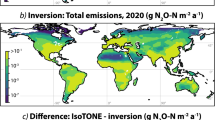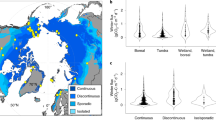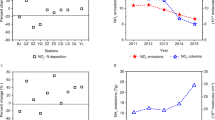Abstract
Additions of reactive nitrogen to terrestrial ecosystems—primarily through fertilizer application and atmospheric deposition—have more than doubled since 1860 owing to human activities 1. Nitrogen additions tend to increase the net uptake of carbon by the terrestrial biosphere, but they also stimulate nitrous oxide release from soils2. However, given that the magnitude of these effects is uncertain, and that the carbon and nitrogen cycles are tightly coupled, the net climatic impact of anthropogenic nitrogen inputs is unknown 3. Here we use a process-based model of the terrestrial biosphere 4,5 to evaluate the overall impact of anthropogenic nitrogen inputs on terrestrial ecosystem carbon and nitrous oxide fluxes between 1700 and 2005. We show that anthropogenic nitrogen inputs account for about a fifth of the carbon sequestered by terrestrial ecosystems between 1996 and 2005, and for most of the increase in global nitrous oxide emissions in recent decades; the latter is largely due to agricultural intensification. We estimate that carbon sequestration due to nitrogen deposition has reduced current carbon dioxide radiative forcing by 96±14 mW m−2. However, this effect has been offset by the increase in radiative forcing resulting from nitrous oxide emissions, which amounts to 125±20 mW m−2.
This is a preview of subscription content, access via your institution
Access options
Subscribe to this journal
Receive 12 print issues and online access
$259.00 per year
only $21.58 per issue
Buy this article
- Purchase on Springer Link
- Instant access to full article PDF
Prices may be subject to local taxes which are calculated during checkout




Similar content being viewed by others
References
Gruber, N. & Galloway, J. N. An Earth-system perspective of the global nitrogen cycle. Nature 451, 293–296 (2008).
Liu, L. L. & Greaver, T. L. A review of nitrogen enrichment effects on three biogenic GHGs: The CO2 sink may be largely offset by stimulated N2O and CH4 emission. Ecol. Lett. 12, 1103–1117 (2009).
Galloway, J. N. et al. Transformation of the nitrogen cycle: Recent trends, questions, and potential solutions. Science 320, 889–892 (2008).
Zaehle, S. & Friend, A. D. Carbon and nitrogen cycle dynamics in the O–CN land surface model: 1. Model description, site-scale evaluation and sensitivity to parameter estimates. Glob. Biogeochem. Cycles 24, GB1005 (2010).
Zaehle, S. et al. Carbon and nitrogen cycle dynamics in the O–CN land surface model: 2. The role of the nitrogen cycle in the historical terrestrial carbon balance. Glob. Biogeochem. Cycles 24, GB 1006 (2010).
Galloway, J. N. et al. The nitrogen cascade. Bioscience 53, 341–356 (2003).
Seitzinger, S. P. et al. Global river nutrient export: A scenario analysis of past and future trends. Glob. Biogeochem. Cycles 24, GB0A08 (2010).
Ravishankara, A., Daniel, J. & Portmann, R. Nitrous oxide (N2O): The dominant ozone-depleting substance emitted in the twenty first century. Science 326, 123–125 (2009).
Sutton, M. A. et al. Uncertainties in the relationship between atmospheric nitrogen deposition and forest carbon sequestration. Glob. Change Biol. 14, 2057–2063 (2008).
Townsend, A., Braswell, B. H., Holland, E. & Penner, J. Spatial and temporal patterns in potential terrestrial carbon storage due to deposition of fossil fuel derived nitrogen. Ecol. Appl. 6, 806–814 (1996).
Holland, E., Lee-Taylor, J., Nevison, C. D. & Sulzman, J. Global N cycle: Fluxes and N2O Mixing Ratios Originating from Human Activity (Oak Ridge National Laboratory, 2005).
Le Quere, C. et al. Trends in the sources and sinks of carbon dioxide. Nature Geosci. 2, 831–836 (2009).
Keeling, C. D. & Whorf, T. P. in Trends: A Compendium of Data on Global Change (Carbon Dioxide Information Analysis Center, Oak Ridge National Laboratory, U.S. Department of Energy, 2006).
MacFarling Meure, C. et al. Law Dome CO2, CH4 and N2O ice core records extended to 2000 years BP. Geophys. Res. Lett. 33, L14810 (2006).
Prinn, R. G. et al. A history of chemically and radiatively important gases in air deduced from ALE/GAGE/AGAGE. J. Geophys. Res. 105, 751–792 (2000).
Nevison, C. D., Mahowald, N. M., Weiss, R. F. & Prinn, R. G. Interannual and seasonal variability in atmospheric N2O. Glob. Biogeochem. Cycles 21, GB3017 (2007).
House, J. I. et al. Reconciling apparent inconsistencies in estimates of terrestrial CO2 sources and sinks. Tellus 55, 345–363 (2003).
Davidson, E. A. The contribution of manure and fertilizer nitrogen to atmospheric nitrous oxide since 1860. Nature Geosci. 2, 659–662 (2009).
Syakila, A. & Kroeze, C. The global nitrous oxide budget revisited. Greenhouse Gas Meas. Manag. 1, 17–26 (2011).
Aber, J. et al. Nitrogen saturation in temperate forest ecosystems—Hypotheses revisited. Bioscience 48, 921–934 (1998).
Sitch, S., Cox, P. M., Collins, W. J. & Huntingford, C. Indirect radiative forcing of climate change through ozone effects on the land-carbon sink. Nature 448, 791–794 (2007).
Hirsch, A. I. et al. Inverse modeling estimates of the global nitrous oxide surface flux from 1998–2001. Glob. Biogeochem. Cycles 20, GB1008 (2006).
Olivier, J. G. J., Bouwman, A. F., Hoek, K. W. V. d. & Berdowski, J. J. M. Global air emission inventories for anthropogenic sources of NOx, NH3 and N2O in 1990. Environ. Pollut. 102, 135–148 (1998).
Ramaswamy, V. et al. in IPCC Climate Change 2001: The Scientific Basis (eds Houghton, J. T. et al.) 351–416 (Cambridge Univ. Press, 2001).
Shindell, D. T et al. Improved attribution of climate forcing to emissions. Science 326, 716–718 (2009).
Lamarque, J. F. et al. Assessing future nitrogen deposition and carbon cycle feedback using a multimodel approach: Analysis of nitrogen deposition. J. Geophys. Res. 110, D19303 (2005).
Alcamo, J., Van Vuuren, D. & Cramer, W. in Ecosystems and Human Well-Being: Scenarios Vol. 2 (eds Carpenter, S., Pingali, P., Bennett, E. M. & Zurek, M.) (Island, 2006).
Canfield, D. E., Glazer, A. N. & Falkowski, P. G. The evolution and future of earth’s nitrogen cycle. Science 330, 192–196 (2010).
Krinner, G. et al. A dynamic global vegetation model for studies of the coupled atmosphere-biosphere system. Glob. Biogeochem. Cycles 19, GB1015 (2005).
Denman, K. L. et al. in IPCC Climate Change 2007: The Physical Science Basis (eds Solomon, S. et al.) 511–539 (Cambridge Univ. Press, 2007).
Acknowledgements
This work was supported by the Marie Curie Reintegration Grant JULIA (PERG02-GA-2007-224775) and the Max Planck Society through the ENIGMA project. We thank F. Dentener and G. Hurtt for providing the nitrogen deposition and land-cover change data, respectively. S.Z. and A.D.F. are supported by the European Community’s Seventh Framework Programme under grant agreement no. 238366.
Author information
Authors and Affiliations
Contributions
S.Z. developed the model, designed and carried out the experiments and performed the analyses. V.P. and A.D.F. helped during the development of the model. All co-authors substantially contributed to interpreting the results and writing the paper.
Corresponding author
Ethics declarations
Competing interests
The authors declare no competing financial interests.
Supplementary information
Supplementary Information
Supplementary Information (PDF 618 kb)
Rights and permissions
About this article
Cite this article
Zaehle, S., Ciais, P., Friend, A. et al. Carbon benefits of anthropogenic reactive nitrogen offset by nitrous oxide emissions. Nature Geosci 4, 601–605 (2011). https://doi.org/10.1038/ngeo1207
Received:
Accepted:
Published:
Issue Date:
DOI: https://doi.org/10.1038/ngeo1207
This article is cited by
-
Evidence and attribution of the enhanced land carbon sink
Nature Reviews Earth & Environment (2023)
-
Poultry litter increased irrigated cotton N uptake with limited improvement on 15N-labelled urea recovery over one season
Nutrient Cycling in Agroecosystems (2023)
-
Advances in Land Surface Modelling
Current Climate Change Reports (2021)
-
Long-term nitrogen addition further increased carbon sequestration in a boreal forest
European Journal of Forest Research (2021)
-
The three major axes of terrestrial ecosystem function
Nature (2021)



